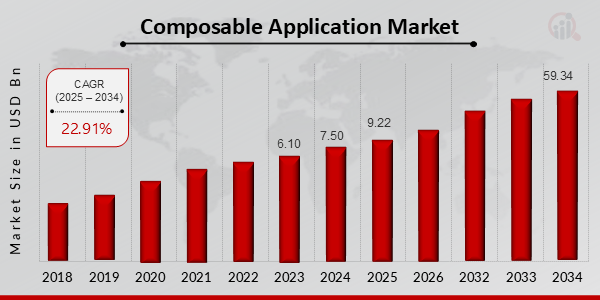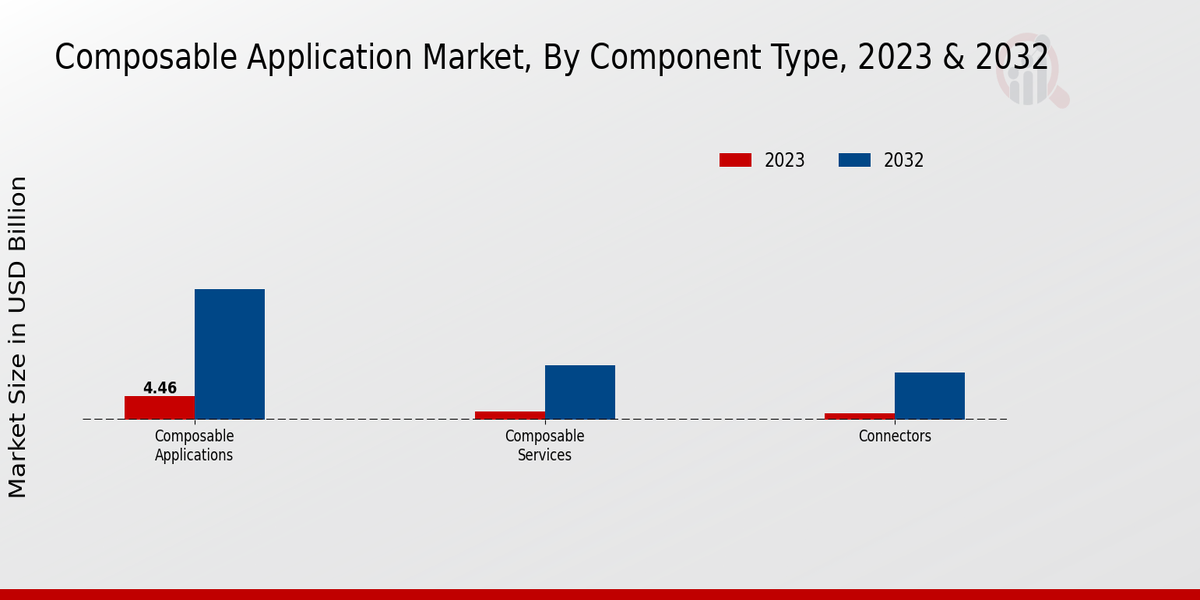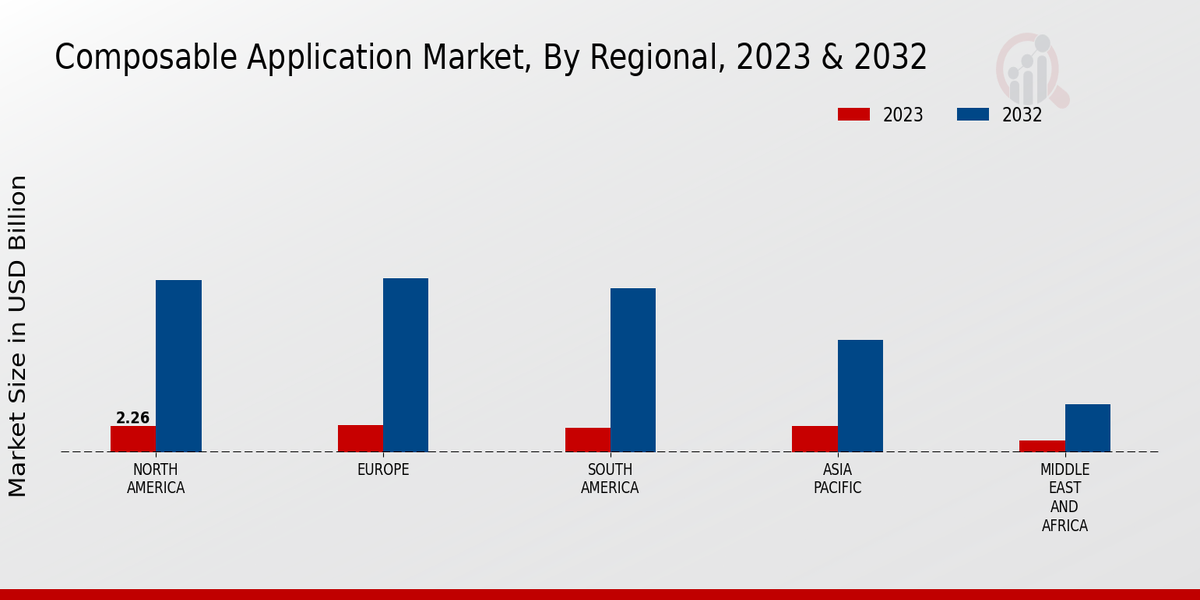Composable Application Market Overview
Composable Application Market is projected to grow from USD 9.22 Billion in 2025 to USD 59.34 Billion by 2034, exhibiting a compound annual growth rate (CAGR) of 22.91% during the forecast period (2025 - 2034). Additionally, the market size for Composable Application Market was valued at USD 7.50 billion in 2024.
Figure 1 Composable Application Market Overview (2025-2034)

Source Primary Research, Secondary Research, MRFR Database and Analyst Review
Key Composable Application Market Trends Highlighted
Composable Application Market Trends
The composable application market is witnessing significant growth driven by the surging demand for agile and flexible software solutions. Key drivers include the need to reduce development time and cost, enhance scalability, and cater to evolving business requirements. Opportunities lie in integrating composable applications into existing systems, improving security, and exploring new business models.
Recent trends include the adoption of cloud-native technologies, microservices architecture, and DevOps practices. Containerization and orchestration tools play a vital role in managing and deploying composable applications. AI/ML integration enhances analytical capabilities, while low-code/no-code platforms simplify application development. Open-source components and standards enable interoperability and reduce vendor lock-in.
Composable Application Market Drivers
Increasing adoption of cloud-native technologies
The increasing adoption of cloud-native technologies is one of the key drivers of the growth of the Composable Application Market Industry. Cloud-native technologies are designed to be deployed and managed in the cloud, and they offer a number of advantages over traditional on-premises software, such as increased scalability, flexibility, and cost-effectiveness. As more and more businesses move to the cloud, the demand for composable applications is expected to grow.
Composable applications are designed to be assembled from reusable components, which makes them easy to develop and deploy. This makes them ideal for businesses that need to quickly and easily create new applications to meet their changing needs.
Growing demand for digital transformation
The growing demand for digital transformation is another key driver of the growth of the Composable Application Market Industry. Digital transformation is the process of using digital technologies to improve business processes and operations. Composable applications can play a key role in digital transformation, as they can help businesses to quickly and easily create new applications that meet their specific needs.
Need for greater agility and innovation
The need for greater agility and innovation is another key driver of the growth of the Composable Application Market Industry. In today's fast-paced business environment, businesses need to be able to quickly and easily respond to changing market conditions. Composable applications can help businesses to do this, as they can be quickly and easily assembled from reusable components.
Composable Application Market Segment Insights
Composable Application Market Component Type Insights
The Composable Application Market is segmented based on component type into Composable Applications, Composable Services, and Connectors. Among these segments, Composable Applications held the largest market share of approximately 40-45% in 2023. The market for Composable Services is projected to grow at the highest CAGR during the forecast period, owing to the increasing adoption of microservices architecture and serverless computing. Composable Applications are self-contained, modular software components that can be easily assembled and reassembled to create new applications.
They offer several advantages over traditional monolithic applications, including faster development time, increased flexibility, and improved scalability. The growing demand for digital transformation and the need for agile and responsive applications are driving the growth of the Composable Applications market. Composable Services are reusable, modular software components that provide specific functionality. They are typically used to build complex applications by combining multiple services together. The increasing adoption of microservices architecture and serverless computing is driving the growth of the Composable Services market.
Microservices architecture allows developers to decompose applications into smaller, independent services, which can be deployed and scaled independently. Serverless computing eliminates the need for managing servers, allowing developers to focus on building and deploying applications. Connectors are software components that enable communication and data exchange between different applications and services. They play a crucial role in building integrated and interoperable IT systems. The growing adoption of multi-cloud and hybrid cloud environments is driving the demand for Connectors.
Multi-cloud and hybrid cloud environments require seamless integration between different clouds and on-premises systems, which can be achieved using Connectors. Overall, the Composable Application Market is expected to witness significant growth in the coming years, driven by the increasing adoption of cloud computing, microservices architecture, and serverless computing.
Figure 2 Composable Application Market By Component Type (2023-2032)

Source Primary Research, Secondary Research, MRFR Database and Analyst Review
Composable Application Market Deployment Model Insights
The Composable Application Market is segmented by Deployment Model into On-Premises, Cloud, and Hybrid. On-Premises This deployment model involves installing and managing the composable application software on the organization's own servers. It provides greater control over data and security but requires significant upfront investment and ongoing maintenance. Cloud With the Cloud deployment model, the composable application is hosted by a third-party provider, such as Amazon Web Services (AWS) or Microsoft Azure. This eliminates the need for organizations to invest in and maintain their own infrastructure, offering greater flexibility and scalability.
The Composable Application Market revenue from the Cloud deployment model is projected to grow significantly over the forecast period, driven by the increasing adoption of cloud-based solutions and the growing need for agility and cost-effectiveness. Hybrid The Hybrid deployment model combines elements of both On-Premises and Cloud deployments. It involves deploying some components of the composable application on-premises and others in the cloud. This approach offers a balance of control and flexibility, allowing organizations to tailor their deployment based on specific requirements. The Hybrid deployment model is gaining traction in the Composable Application Market as organizations seek to optimize their infrastructure and leverage the benefits of both on-premises and cloud deployments.
Composable Application Market Industry Vertical Insights
The Composable Application Market is segmented by Industry Vertical into Banking, Financial Services, and Insurance (BFSI), Healthcare, Manufacturing, Retail, and Telecommunications. Among these segments, BFSI is expected to hold the largest market share in 2023, owing to the increasing adoption of composable applications in the financial sector to enhance operational efficiency and customer experience. The Healthcare segment is also expected to witness significant growth due to the rising demand for personalized and data-driven healthcare solutions. Manufacturing, Retail, and Telecommunications are other key industry verticals that are expected to drive the growth of the Composable Application Market, as composable applications offer benefits such as faster time-to-market, improved agility, and reduced costs.
Composable Application Market Size of Organization Insights
The Composable Application Market segmentation by Size of Organization includes Small and Medium-Sized Enterprises (SMEs) and Large Enterprises. The SME segment is expected to hold a significant share of the market, owing to the increasing adoption of composable applications to improve operational efficiency and reduce costs. SMEs are increasingly recognizing the benefits of composable applications, such as their flexibility, scalability, and cost-effectiveness. Large Enterprises are also expected to contribute significantly to the market growth, as they are investing in composable applications to improve their IT infrastructure and gain a competitive advantage. The Composable Application Market revenue is projected to grow significantly over the forecast period, driven by the increasing adoption of composable applications across various industries.
Composable Application Market Application Function Insights
The Composable Application Market is segmented by Application Function into Customer Relationship Management (CRM), Enterprise Resource Planning (ERP), Supply Chain Management (SCM), Human Capital Management (HCM), and Data Analytics and Business Intelligence. CRM applications are expected to hold the largest market share due to the increasing adoption of cloud-based CRM solutions and the growing need for improved customer engagement. ERP applications are also expected to witness significant growth due to the increasing demand for integrated business management solutions.SCM applications are expected to grow at a steady pace due to the growing need for efficient supply chain management.
HCM applications are expected to witness moderate growth due to the increasing adoption of cloud-based HCM solutions and the growing need for improved employee management. Data Analytics and Business Intelligence applications are expected to grow at a rapid pace due to the increasing demand for data-driven insights and the growing adoption of big data technologies. The Composable Application Market is expected to reach USD 31.787 Billion by 2032, growing at a CAGR of 22.91% from 2023 to 2032.
Composable Application Market Regional Insights
The regional segmentation of the Composable Application Market offers insights into the market's geographic distribution and growth potential. North America dominated the market, accounting for a significant share of the Composable Application Market revenue in 2023. The region's high adoption of cloud computing and advanced technologies, coupled with the presence of major technology companies, drives growth in this region. Europe is another key market, with a strong focus on digital transformation and a growing demand for composable applications.
The APAC region is anticipated to witness substantial growth in the coming years, driven by the increasing adoption of composable applications in various industries and government initiatives promoting digitalization. South America and MEA are emerging markets with growing potential for composable applications, as organizations seek to modernize their IT infrastructure and improve operational efficiency.
Figure 3 Figure 2 Composable Application Market By Regional (2023-2032)

Source Primary Research, Secondary Research, MRFR Database and Analyst Review
Composable Application Market Key Players And Competitive Insights
Major players in the Composable Application Market industry are constantly striving to gain a competitive edge by introducing innovative solutions. Leading Composable Application Market players are collaborating with other companies to expand their product portfolio and reach new markets. The Composable Application Market development is driven by the increasing demand for agility and flexibility in business applications. The competitive landscape of the Composable Application Market is expected to remain highly competitive in the coming years.OutSystems is a leading provider of low-code development platforms. The company's platform enables developers to quickly and easily build and deploy complex business applications. OutSystems has a strong customer base of over 1,000 organizations, including many Fortune 500 companies. The company is headquartered in Lisbon, Portugal, and has offices in the United States, Europe, and Asia.
Mendix is another leading provider of low-code development platforms. The company's platform is known for its ease of use and flexibility. Mendix has a strong customer base of over 4,000 organizations, including many large enterprises. The company is headquartered in Boston, Massachusetts, and has offices in the United Kingdom, the Netherlands, and Germany.
Key Companies in the Composable Application Market Include
Composable Application Market Industry Developments
The composable application market is projected to reach USD 31.787 billion by 2032, exhibiting a CAGR of 22.91% during the forecast period (2024-2032). This growth can be attributed to the increasing adoption of cloud-native technologies, the need for agility and flexibility in business applications, and the growing popularity of low-code/no-code development platforms.
Recent news developments in the market include the launch of new composable application platforms by major vendors such as SAP and Oracle, as well as the growing adoption of open source composable application frameworks such as the Open Composable Framework (OCF). Additionally, the market is witnessing a surge in strategic partnerships and acquisitions, as vendors seek to expand their offerings and gain market share.
Composable Application Market Segmentation Insights
Composable Application Market Component Type Outlook
- Composable Applications
- Composable Services
- Connectors
Composable Application Market Deployment Model Outlook
Composable Application Market Industry Vertical Outlook
- Banking, Financial Services, and Insurance
- Healthcare
- Manufacturing
- Retail
- Telecommunications
Composable Application Market Size of Organization Outlook
- Small and Medium-Sized Enterprises (SMEs)
- Large Enterprises
Composable Application Market Application Function Outlook
- Customer Relationship Management (CRM)
- Enterprise Resource Planning (ERP)
- Supply Chain Management (SCM)
- Human Capital Management (HCM)
- Data Analytics and Business Intelligence
Composable Application Market Regional Outlook
- North America
- Europe
- South America
- Asia Pacific
- Middle East and Africa
|
Report Attribute/Metric
|
Details
|
|
Market Size 2024
|
7.50 (USD Billion)
|
|
Market Size 2025
|
9.22 (USD Billion)
|
|
Market Size 2034
|
59.34 (USD Billion)
|
|
Compound Annual Growth Rate (CAGR)
|
22.91% (2025 - 2034)
|
|
Report Coverage
|
Revenue Forecast, Competitive Landscape, Growth Factors, and Trends
|
|
Base Year
|
2024
|
|
Market Forecast Period
|
2025 - 2034
|
|
Historical Data
|
2019 - 2023
|
|
Market Forecast Units
|
USD Billion
|
|
Key Companies Profiled
|
AWS, Amazon Web Services (AWS), Oracle, Microsoft, UiPath, Pegasystems, SAP, IBM, Salesforce, OutSystems, Google Cloud, Tibco Software, Bizagi, Appian, Mendix
|
|
Segments Covered
|
Component Type, Deployment Model, Industry Vertical, Size of Organization, Application Function, Regional
|
|
Key Market Opportunities
|
Increasing adoption in cloudnative environments growing demand for microservices architecture rising need for faster time to market expanding use in diverse industry verticals and advancements in low code no code platforms
|
|
Key Market Dynamics
|
Increasing demand for agility composable architecture adoption microservices adoption cloud adoption growing investment in digital transformation
|
|
Countries Covered
|
North America, Europe, APAC, South America, MEA
|
Frequently Asked Questions (FAQ) :
The Composable Application Market is expected to be valued at USD 7.50 billion in 2024.
The Composable Application Market is projected to grow at a CAGR of 22.91% from 2025 to 2034.
North America is expected to hold the largest market share in the Composable Application Market in 2024.
The BFSI industry vertical is expected to drive the growth of the Composable Application Market.
Some of the key competitors in the Composable Application Market include OutSystems, Mendix, Salesforce, and Microsoft.
The key factors driving the growth of the Composable Application Market include the increasing demand for agility and flexibility in business applications, the rising adoption of cloud computing, and the growing need for faster time-to-market.
The key challenges facing the Composable Application Market include the lack of skilled professionals, the complexity of composable architectures, and the need for a robust integration infrastructure.
The key trends in the Composable Application Market include the increasing adoption of low-code/no-code development platforms, the rising popularity of serverless computing, and the growing use of artificial intelligence (AI) and machine learning (ML) in composable applications.
The key opportunities in the Composable Application Market include the development of new composable application platforms, the expansion of the composable application ecosystem, and the growing adoption of composable applications in emerging markets.
The key risks in the Composable Application Market include the lack of standardization, the security risks associated with composable applications, and the potential for vendor lock-in.

















